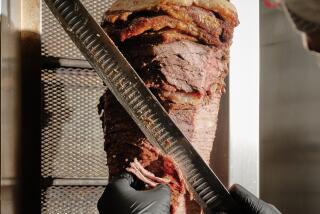Culture Club : In the Yogurt Belt
- Share via
Cheese has been called milk’s leap to immortality. Yogurt doesn’t have the same vaulting artistic ambitions. Originally it was just milk’s bid for longer shelf life.
Of course, it’s a commonplace that yogurt can apparently give all of us a longer shelf life too. Every day, it seems, somebody claims yogurt is doing us some new favor: lowering blood cholesterol, preventing colon cancer, protecting the stomach lining, helping food to digest, enabling us to live to 120.
I have reason to know about some of the benefits of yogurt. Once upon a time, thanks to some positively foolhardy dining choices, I came down with ferocious dysentery in a Near Eastern country. The owner of the little hotel where I was staying sympathetically recommended yogurt and tea, which turned out to be all I could keep in my stomach for a couple of weeks.
When I got back to California, the diagnosis showed I was home to half a dozen intestinal parasites (“You’re a menagerie,” said the doctor with an unpleasant little chuckle). To clear it up I had to take a violent course of antibiotics. When it was over, the doctor prescribed . . . yogurt, to colonize my now-depopulated digestive tract with friendly bacteria.
In time, people learned of the health benefits of yogurt, and in many countries the tart, funky flavor of yogurt became part of the culinary palette. (In this country, we’re still just beginning to like the naked flavor of yogurt. Because of our famous national sweet tooth, we mostly eat it with fruit, which strikes people from yogurt-eating countries as bizarre.) But to begin with, yogurt was just a way of keeping milk from spoiling.
Today, with refrigeration and pasteurization, we’re no longer aware of the real danger milk drinking once posed. We’re not the only creatures who like to feed on nature’s most nearly perfect food, and a lot of these tiny organisms are bad for us. But the culturing process converts the sugar in milk (lactose) into lactic acid. The acidity discourages other microbes from moving into the mix; well-made yogurt will stay wholesome for days, even without refrigeration.
Conveniently, the lactose that was consumed in culturing is the very thing that makes milk difficult to digest for many people. In many parts of Africa and Asia, yogurt is the only dairy food people can consume.
All of this was a trial-and-error discovery, obviously. Was the process of scalding the milk before culturing it a primitive pasteurization technique, or was it just part of the process of getting the milk to the right temperature for the bacteria to grow? At any rate, eventually people learned to save some of the last batch of yogurt as a starter for the next batch, just as they saved some sour dough to leaven their next batch of bread.
Particularly in warm climates, and among nomadic people whose storage facilities were limited, the culturing of milk was an invaluable way of saving the product of their flocks. There’s a vast yogurt belt extending from Morocco to western China and including all of India. Clearly, no one nation can claim to have invented it, not the Turks (though yogurt is a Turkish word) nor the Bulgarians (though one of the bacteria is known as Lactobacillus bulgaricus).
When you have a lot of yogurt on hand, you tend to develop a lot of uses for it. In the yogurt belt, it’s mixed with vegetables (above all, sliced cucumber) and added to soups and stews. When we try these recipes, we have to remember that cow’s milk yogurt curdles when it comes to a boil, so you have to stabilize it with flour, cornstarch or egg white and stir constantly as it cooks.
Yogurt is often diluted with water to make an appetizingly tart drink called laban in Arabic, ayran or chalab in Turkish, taan in Armenian and lassi in most Indian languages. You can get bottled taan at any Armenian market in Los Angeles--even carbonated taan.
On the other hand, water is often removed from yogurt. If you stir yogurt up (preferably with a dash of salt to get things started) and hang it in a clean cloth, the whey will drip out and leave a rich concentrated yogurt more or less like a sour cream cheese.
This thickened yogurt or “yogurt cheese” is known as lebneh in Arabic, suzme in Turkish and yaourti tou ponghiou (“pocket yogurt”) in Greek. In that part of the world, it’s often served with olives and bread for breakfast. In Syria they roll up balls of lebneh in the tart dried berries of the sumac plant and store them in olive oil for a particularly highly flavored accompaniment to bread and olives; this is called shanklish. In Central Asia, people knead thickened yogurt with chopped green onions, cayenne pepper and mixed herbs such as basil, mint and cilantro and consider it a salad, suzme salatasi.
In the Middle Ages, a Near Eastern banquet often began with an ancient Iranian appetizer known as bazmawurd , or “that which brings the banquet.” Originally part of the cuisine of the Persian kings, this consisted of a flat, tortilla-like bread spread with thickened yogurt (or goat cheese) mixed with herbs, chopped nuts and black olives. It would be rolled up, warmed in the oven and sliced into canapes.
But whatever you do with yogurt, remember one thing: If you’re taking antibiotics, wait an hour after eating any yogurt before taking the medication. Yogurt can interfere with the medicine’s effectiveness.
More to Read
Eat your way across L.A.
Get our weekly Tasting Notes newsletter for reviews, news and more.
You may occasionally receive promotional content from the Los Angeles Times.









